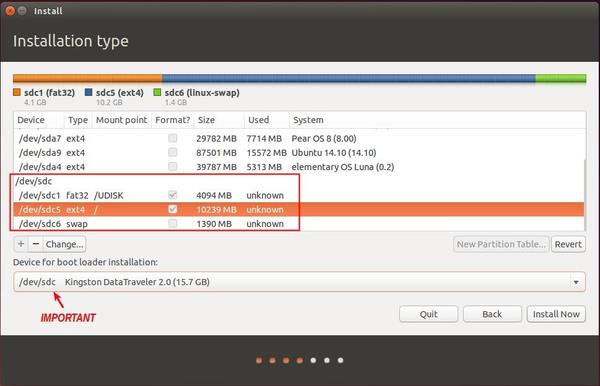
- #Install linux on usb for persistence install#
- #Install linux on usb for persistence drivers#
- #Install linux on usb for persistence full#
- #Install linux on usb for persistence software#
- #Install linux on usb for persistence password#
Other times, breaking it up into smaller jobs works. In those cases, swap on ZRAM can work often work around the issue. The systems I use now rarely swap except for a handful that run ad-hoc jobs that try to do things like load a huge file into RAM before loading it into a database over the network. No process was using a huge amount of RAM, there just wasn't much RAM to begin with. The difference was that exim might need to be swapped in to handle an email, while it swapped out apache httpd. The Linux kernel of that era was much better at making swap imperceptible than Windows 3.1. Swap to disk was really nice to have when I had a 486 SX 25 with 4MB of RAM running Debian 1.1. I have read articles suggesting that it is somehow faster to use disk in place of RAM sometimes, but that has never been my observation.
#Install linux on usb for persistence drivers#
The open drivers are plenty good for most uses.I tend to run without swap on laptop systems with 4GB of RAM unless it's Fedora with swap on ZRAM enabled by default. For maximum compatibility, don't use them. This primarily concerns the use of proprietary drivers. Second, as the system thinks it's installed normally, it will tend to make changes that are ideal for the hardware you're currently working with, but not necessarily hardware you'll encounter in the future. But with 128GB and 256GB drives having drastically dropped in price, you don't need to spend a lot of money to run Linux on a flash drive comparable in size to an SSD. If your only option is an old drive lying around, 8GB is feasible. Granted, that's not as much of an issue as it used to be. But there are still a few downsides.įirst, you'll need a larger USB drive for this type of installation. The advantages are pretty obvious: you get your own system setup just the way you like it, right in your pocket.
#Install linux on usb for persistence full#
You'll have to use a disc or another USB drive for the installation media, but this method literally lets you have a full Linux system in your pocket-one that is as flexible as any other traditional installation.

#Install linux on usb for persistence install#
Lastly, you can choose to do a full install onto the USB drive.
#Install linux on usb for persistence software#
Also, you have to be careful with software updates, as newer kernels could break the bootloader.
#Install linux on usb for persistence password#
The downsides: you automatically boot into the live user account, which isn't password protected. So the advantage in this scenario is that you can save your stuff, use up less drive space, and have maximum support for whatever hardware you plug into. Having persistent data is ideal if you use a large variety of systems with the USB drive, as the live environment will detect what hardware is available every time it boots. The tool will run on Ubuntu and Debian-based distros, plus some others. If you're already on Linux, you might try mkusb instead. One option is Rufus, a Windows app that supports creating live Linux USB sticks with persistent storage. To make this work, you will need a compatible program to perform the installation. This is great: it lets you write a relatively compact ISO file to boot from, and you can actually keep your extra installed applications and saved documents. However, if you're wanting to use the drive as a way to perform secure communications (think banking, or any activities that require the use of TOR) and ensure that no sensitive information is stored anywhere, this is definitely the way to go.ĭepending on your distro, you may have the option to enable persistent data on your USB drive. If you'd like to keep a customized Linux environment in your pocket, this isn't what you want. As a Live environment, all data is kept in RAM and none of it is written to the USB drive therefore, none of it is saved when the system turns off. However, the downside to this approach is that you'll lose all of your data as soon as you shut down or restart the computer you're working on.


While burning an ISO isn't as complicated as it sounds, Etcher is about as simple as it gets. One option is balenaEtcher, a free and open source tool available for Linux, macOS, and Windows. There are plenty of tools that can burn an ISO for you, and this method is compatible with virtually every Linux distribution out there. From there, you can boot up a Linux system on any computer that supports booting from USB media. It has become really easy to take an ISO image of your favorite Linux distribution and write it to any appropriately sized USB drive.


 0 kommentar(er)
0 kommentar(er)
